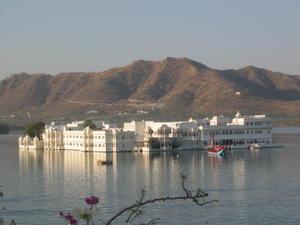Advertisement
Published: July 12th 2006

 Udaipur - March 8, 2006
Udaipur - March 8, 2006
The Lake Palace, with the Aravalli Hills in the background, as seen from the rooftop of our guesthouse. Udaipur, city of sunrise, city of white, sits in the Eirwa Valley of Southern Rajasthan, as witness to the Aravalli Hills, rocky out croppings in semi arid, sandy, stingy soil. The city was founded in 1568 by Maharana Udai Singh and surrounds Lake Pichola, the placid. Four palaces frame the lake, along with ghats, gardens, temples, a mosque and havelis, homes of the nobles from those pristine times.
The City Palace is just up hill from the lake; and showcases the Maharanas of Mewer, their possessions and contributions to the realm; all seventy-six rulers, from 546 AD to date. Though no longer a sovereign, the current Maharana, Shriji Arvind Singh, still lives there; and attends weekly pooja, prayers with his people. A modern man, engaged in the hotel business, he has also been engaged in path finding design of a solar-powered water taxi, which works; and an auto rickshaw, that would be environmentally friendly, if it goes operational.
By day, from outside, the City Palace is all crenellations and canopies, towers and turrets. Inside, the glass works are enchanting expressions of accomplished artisanship. This is installation art in the medium of glass, extensive enough to encompass entire rooms

 Udaipur - March 8, 2006
Udaipur - March 8, 2006
Havelis homes on Lake Pichola seen through the windows of our guesthouse. and form full domes; delicate enough to create life-size, life-like birds, including colourful peacocks, by any measure demanding to reproduce.
In 1987, Shriji Arvind Singh put a startling collection of cut-crystals on display within the City Palace. It had sat in storage since the 18-seventies, because Maharana Sajjan Singh, who placed the order on a Birmingham factory, passed away, between purchase order and delivery. Three teardrop chandeliers of cut crystal, fourteen feet long, ten feet diameter, are joined by six others, half their size, to illuminate the ornate dining room. There is a complete four poster bed, a number of side bars, several chairs, a miniature temple to Ganesh the son of Siva and Duprati; a fan, an oval table, a round table; the list goes on, all cut crystal, before we get to simple, and presumably necessary items, like glasses, decanters, picture frames and a be-jeweled carpet, mercifully wall hung. The proud guard tending us advises that cut-crystal is merely an amalgam of sand, silicon, lead and glass; cut and polished; really. When cut-crystals are unable to hold the furniture together, nickel, gold or silver is volunteered for the task. We can not take it anymore; and leave

 Udaipur - March 8, 2006
Udaipur - March 8, 2006
Gardens at the gate of the City Palace.the collection, chastened, to the strains of classical Indian music wafting softly from viola and drum.
The Monsoon Palace, five stories high, is up a cliff on a close-by hill. It was built late 19th century as an observatory. No longer in use as such, it throws off dim lighting in the evenings, adding to night time magic.
The Mandir Palace, across the lake from the City Palace, is home to a remarkable dome pavilion. The palace is of yellow sandstone, inlaid with marble. Sandstone under lights at night time is dreamy. The kiosks and a pool in the courtyard are positioned, in conformance with the four cardinal points, according to the rules of ancient Hindu architecture; line up one kiosk with, say, the sun and all other directions are clear. Shah Jahan of Taj Mahal repute, took refuge here for a while when he was a prince of the Mughal realm.
The Summer Palace, now a hotel, is a white dreamboat that sits on the lake like a swan at peace, unhurried. By night, all lit up, it plays on the mind, as though candles are slowly melting the icing of a festive birthday cake.

 Udaipur - March 8, 2006
Udaipur - March 8, 2006
City Palace - stained glass alcove. It is in the evening, from the rooftop of a Haveli turned restaurant, that the essence of Udaipur is revealed. The mountain range, low in the coal dust sky, its presence perceived by extra sense rather than sight, gently nudges attention to the placid lake below. The jet darkness of the night offers a sheer, black, velvet backdrop, upon which lights from the palaces do a darting dance. Here, a glittering glow that dazzles the lake; there, a caring caress of the lakeshore; across the water, a flicker to us admirers; and from up the hill, a nodding, knowing wink of good night. All the while, a finely crafted chain of lights, from other gaily illumined Havelis, links the four artful palace players. And, we are enjoined in the wonder of the moment, as the soulful sounds of horns from the temple in the foothills, hauntingly decree that a magical evening is well and truly ended.
Vernon
Advertisement
Tot: 0.125s; Tpl: 0.01s; cc: 14; qc: 71; dbt: 0.0721s; 1; m:domysql w:travelblog (10.17.0.13); sld: 1;
; mem: 1.2mb

 Udaipur - March 8, 2006
Udaipur - March 8, 2006
 Udaipur - March 8, 2006
Udaipur - March 8, 2006 
 Udaipur - March 8, 2006
Udaipur - March 8, 2006
 Udaipur - March 8, 2006
Udaipur - March 8, 2006 


